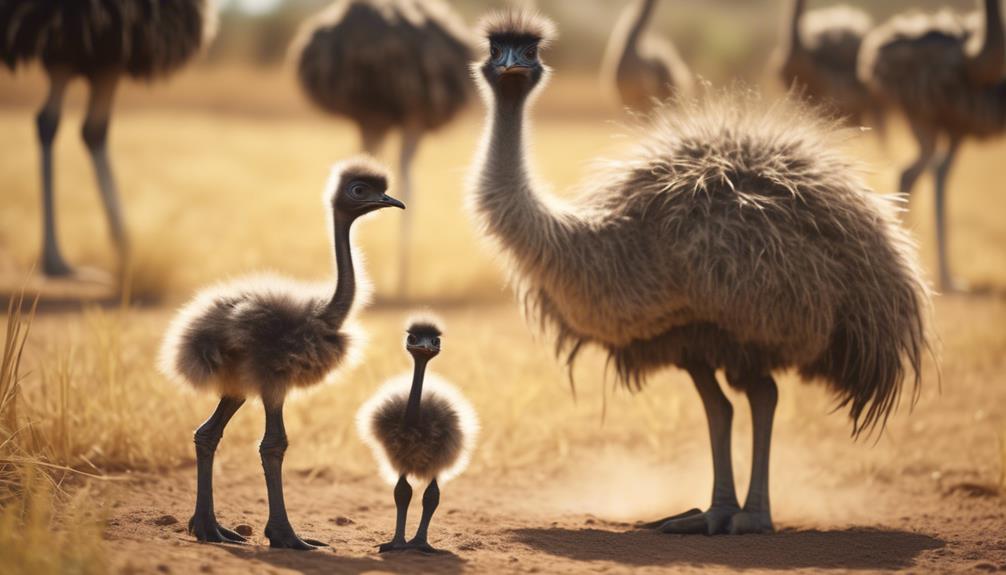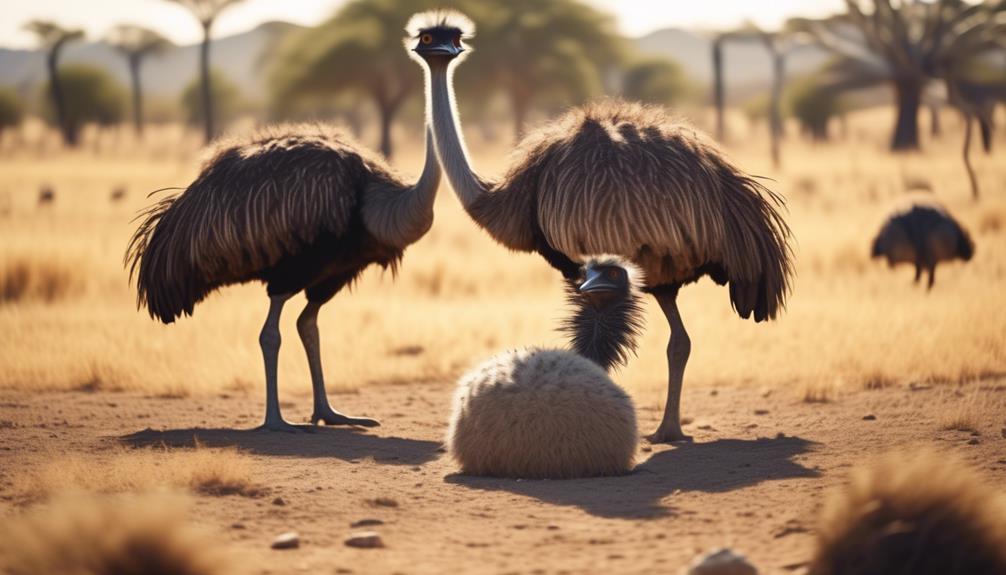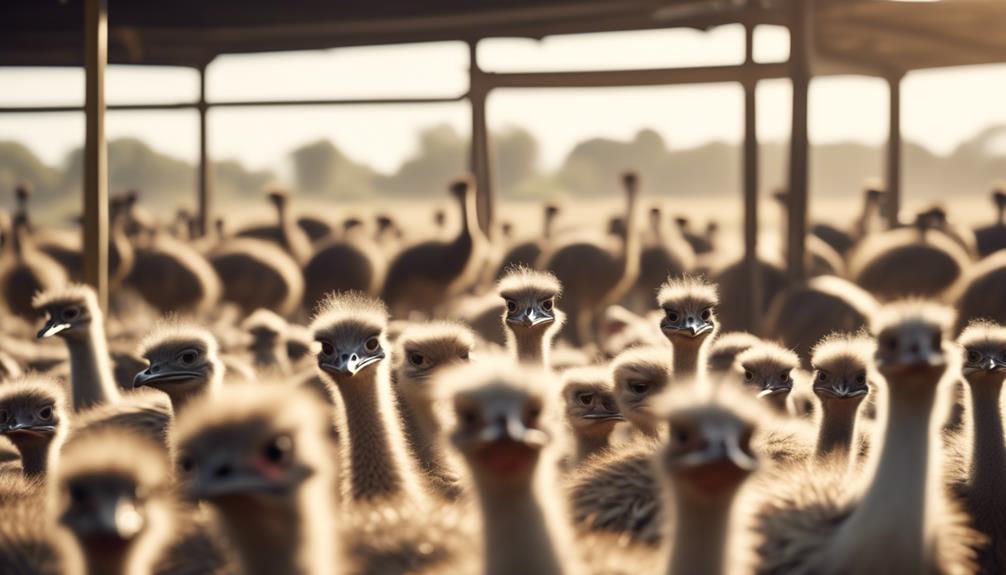
You may be wondering why it's necessary to understand the agricultural differences between emus and ostriches.
After all, aren't they both just large flightless birds? While they may share some similarities, delving into their distinct characteristics and farming practices reveals a fascinating world of contrasts.
From their growth rates and diet preferences to their breeding and reproduction methods, each species presents unique challenges and opportunities for farmers.
In this discussion, we will explore these differences and their implications for agricultural practices.
Get ready to uncover the secrets behind these captivating birds and discover why understanding their agricultural disparities is crucial for success in the industry.
Growth Rates

When comparing the growth rates of emus and ostriches, it's evident that emus tend to exhibit a slightly higher rate of growth than their ostrich counterparts. Emus typically reach their full adult size within 18 to 24 months, whereas ostriches take around 24 to 30 months to achieve the same growth. This faster growth rate can be attributed to various factors.
One factor that contributes to the faster growth of emus is their environmental impact. Emus are highly adaptable birds that can thrive in a range of different climates and habitats. They're known for their resilience and ability to withstand harsh conditions, which enables them to grow at a quicker pace. Ostriches, on the other hand, are more sensitive to environmental changes and require specific conditions for optimal growth.
Another factor that influences the growth rates of emus and ostriches is market demand. Emus are widely sought after for their lean meat, flavorful eggs, and valuable oil, which has led to increased breeding and production efforts. This focus on selective breeding has resulted in the development of emus with accelerated growth rates. In contrast, ostriches haven't experienced the same level of market demand, leading to less emphasis on breeding for growth rate enhancement.
Diet Preferences
Emus and ostriches have distinct diet preferences that contribute to their differing growth rates and overall agricultural differences. Understanding their feeding habits and nutritional requirements is crucial for successful farming. Here are three key points to consider:
- Emus are omnivores: Emus have a more varied diet compared to ostriches. They consume a wide range of plants, insects, small animals, and even fruits. This flexibility allows them to adapt to different environments and have a higher chance of finding suitable food sources.
- Ostriches are herbivores: Ostriches primarily feed on grasses, leaves, seeds, and flowers. They've evolved to thrive on a plant-based diet, which is reflected in their digestive system. Their long necks and beaks enable them to reach vegetation at varying heights, making them efficient grazers.
- Nutritional requirements: Both emus and ostriches have specific nutritional needs. Emus require a diet rich in protein, vitamins, and minerals to support their growth and reproduction. Ostriches, on the other hand, need a diet that's high in fiber to maintain their digestive health. Meeting these requirements ensures optimal growth and overall health for both species.
Breeding and Reproduction

Breeding and reproduction play a crucial role in the agricultural differences between emus and ostriches. Both birds have distinct breeding techniques and face unique reproductive challenges.
| Emu | Ostrich | |
|---|---|---|
| Breeding Techniques | Emus form monogamous pairs that mate for life. During breeding season, the male emu builds a nest and attracts a female by making deep drumming sounds. Once the female lays her eggs, the male takes on the responsibility of incubating them for around 56 days. Ostriches, on the other hand, have a more complex breeding system. One dominant male mates with several females in a communal nest. The dominant male will incubate the eggs during the day, while the females take turns at night. | |
| Reproductive Challenges | Emus face challenges related to egg fertility and hatchability. The female emu can produce fertile eggs without a male, but the chances of successful hatching are low. To overcome this, artificial insemination is often used to increase the chances of successful reproduction. Ostriches, on the other hand, face challenges related to breeding behavior and compatibility. Some ostrich pairs may not have successful matings due to aggression or incompatibility. In such cases, specialized breeding techniques, like embryo transfer, are used to ensure successful reproduction. |
Understanding the breeding techniques and reproductive challenges of emus and ostriches is essential for farmers and breeders. By implementing appropriate breeding techniques and overcoming reproductive challenges, farmers can ensure a successful and sustainable breeding program for these magnificent birds.
Farming Practices
To effectively manage and optimize the farming practices of emus and ostriches, it's important to understand the key factors that contribute to their overall health and productivity. When it comes to farming practices, there are three main areas that require attention: irrigation techniques, pest control methods, and diet management.
- Irrigation techniques: Both emus and ostriches require access to clean water for drinking and bathing. Implementing efficient irrigation systems, such as drip irrigation or sprinklers, ensures that they've a constant supply of water. It's crucial to monitor water quality regularly to prevent contamination and maintain the health of the birds.
- Pest control methods: Emus and ostriches are susceptible to various pests and parasites that can negatively impact their health and productivity. Using integrated pest management techniques, such as regular inspections, proper sanitation, and the use of organic pest repellents, helps to control pests effectively without harming the birds or the environment.
- Diet management: Providing a balanced and nutritious diet is essential for the well-being of emus and ostriches. Their diet should consist of a mix of grains, legumes, vegetables, and commercially formulated feeds. Regularly consulting with a veterinarian and nutritionist can help ensure that the birds are receiving the proper nutrients and their feed is adjusted according to their specific needs.
Economic Considerations

When considering the economic aspects of farming emus and ostriches, it is important to analyze factors such as initial investment costs and potential returns. A cost analysis will help you determine the financial viability of each venture and make an informed decision. Additionally, understanding market demand is crucial in ensuring profitability.
To provide a clear comparison, let's take a look at the cost analysis and market demand for farming emus and ostriches:
| Factors | Emus | Ostriches |
|---|---|---|
| Initial Investment Costs | Lower initial investment costs | Higher initial investment costs |
| Potential Returns | Lower potential returns | Higher potential returns |
| Market Demand | Growing market demand for emu products | Established market demand for ostrich products |
As you can see, farming emus requires a lower initial investment compared to ostriches. However, the potential returns for ostrich farming are higher due to the established market demand for ostrich products. On the other hand, there is a growing market demand for emu products, presenting an opportunity for growth in the industry.
To make a well-informed decision, it is essential to consider your financial capability, market conditions, and long-term goals. By thoroughly evaluating the cost analysis and market demand, you can determine which option best suits your needs and maximize your chances of success.
Frequently Asked Questions
How Long Does It Take for an Emu or Ostrich to Reach Full Size and Maturity?
It takes an emu or ostrich around 2-3 years to reach full size and maturity. During this time, they experience average weight gain and have specific nutritional requirements to support their growth and development.
Can Emus or Ostriches Be Fed a Vegetarian Diet?
You can feed emus and ostriches a vegetarian diet. Emus Vs Ostriches: Are There Health Benefits to a Vegetarian Diet? The Impact of a Vegetarian Diet on Emu and Ostrich Meat Quality is also significant.
Are Emus or Ostriches Able to Reproduce Without the Assistance of Humans?
You'll be amazed to learn that both emus and ostriches have remarkable reproductive capabilities. They are able to naturally breed without any human assistance, showcasing their innate ability to continue their species.
What Are the Best Farming Practices for Emus and Ostriches in Terms of Their Living Conditions?
When it comes to farming emus and ostriches, you need to consider the challenges of emu farming and the techniques used for ostrich farming. Both require specific living conditions to thrive and produce high-quality products.
How Much Profit Can Be Made From Farming Emus or Ostriches Compared to Other Agricultural Ventures?
You're wondering about the profitability of farming emus or ostriches compared to other ventures. Well, let me tell you, the market demand for these magnificent birds can be quite lucrative if managed wisely.
Conclusion
In conclusion, when it comes to the agricultural differences between emus and ostriches, the two birds have distinct characteristics that impact their growth rates, diet preferences, breeding and reproduction, farming practices, and economic considerations.
While the emu symbolizes resilience and adaptability, the ostrich represents strength and speed.
Understanding these differences can help farmers make informed decisions and maximize their agricultural success.




